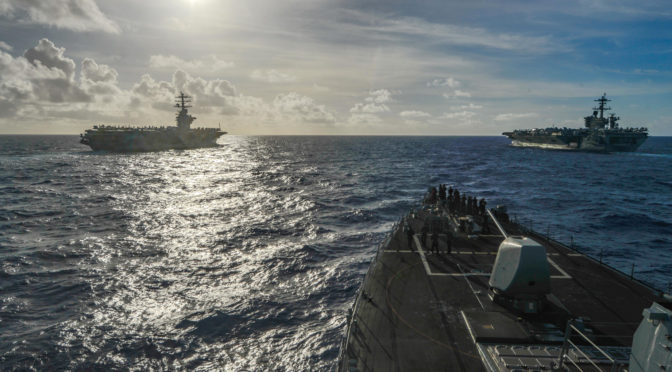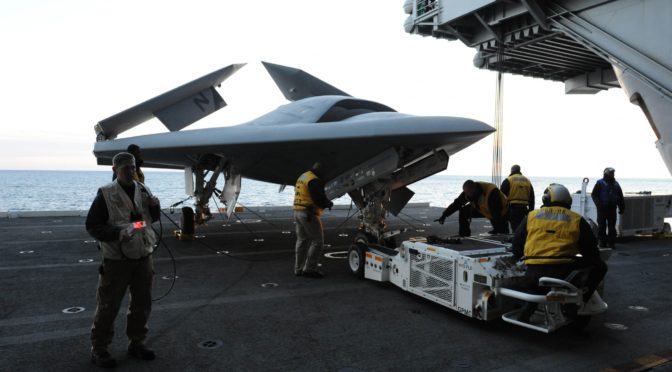Force Structure Perspectives Series
By Dmitry Filipoff
As a part of CIMSEC’s Force Structure Perspectives Series, CIMSEC discussed the Battle Force 2045 fleet design with Col. T.X. Hammes (ret)., a Distinguished Research Fellow at the U.S. National Defense University. In this conversation, Col. Hammes discusses whether this fleet can be afforded, how novel warfighting concepts provide a point of departure for experimentation, and how the increasing lethality of modern weaponry is driving changes in fleet design.
The Secretary of Defense recently announced a new fleet plan for a future U.S. Navy of 500 ships, a major increase over today’s fleet of around 300 ships. Among many changes, the fleet emphasizes substantial additions in areas such as sealift, unmanned warships, submarines, and smaller surface combatants. What do you make of the size of this fleet and its mix of platforms?
The increase in submarines and unmanned underwater vehicles (UUVs) is a positive sign. As SecDef noted, submarines remain our most survivable platforms today. When combined with unmanned underwater vehicles, new mines, and new torpedoes, they can dramatically increase the PLA Navy’s problems in penetrating the first island chain.
The jury is still out on unmanned surface vessels (USVs). One issue will be how to prevent their seizure during peacetime by manned commercial surface vessels – whether simply pirates or state sponsored. While it remains unclear how unmanned surface vessels with be protected and armed, it is encouraging that the Navy is currently examining different ways to increase the number of platforms available for a wide variety of missions. Although not mentioned by SecDef, the Navy is exploring the concept of missile merchants to provide major increases in lethality (increasing the number of missile tubes at sea) and numbers of distributed assets at relatively low cost. Since these ships will need crews of only 40-50, they may be an interim step to fully unmanned surface vehicles. They also address the major issue facing all the services – the increasing cost of personnel.
Given the rapid diffusion and marked increase in the range of anti-ship missile systems, the reduction in the number of very large platforms – carriers and large-deck amphibs – is also a positive development. But the cuts seem to be minimal. The Chinese have modified the H-6 bomber to deliver a modified DF-21 anti-ship ballistic missiles to a range of well over 2,000 miles. Even the air wing of the future will not be able to reach anywhere near that far when (if) it is fielded a decade from now. The Secretary stated that the primary roles of the carriers and potential light carriers will be deterrence, power projection, and sea control. Power projection will be problematic due to the fact land-based air and missile systems continue to outrange naval aviation. Deterrence is in the eye of the beholder and may well work against medium or small powers, but China has clearly worked hard to neutralize the carriers.
Sea control remains a vital role for air-capable platforms. This will provide a continuing role for the large-deck carrier, but one has to question whether we need eight to carry out this mission. The enormous cost of the carrier, its air wing, personnel, operations and maintenance cost, and long expensive training pipelines makes this an enormous investment. Given projected budget constraints, we need to consider if using increasingly capable Vertical Take-Off and Landing (VTOL) capable drones on smaller platforms can’t achieve the same mission at a vastly reduced cost while freeing the escorts from protecting the carrier. We should be seeking to impose costs on our opponents, not ourselves.
Major cuts in large surface combatants with concurrent increases in small surface combatants also reflect significant changes in the character of naval warfare in an age of mass missile attacks. It is in keeping with Captain Wayne Hughes’ concepts of missile age warfare. The combination of more small missile capable ships, potentially missile-armed USVs, and missile merchants could provide the U.S. Navy with many more missiles systems at much less cost. This creates more problems for our competitors.
This new force structure may be used to execute Navy and Marine Corps warfighting concepts, including Distributed Maritime Operations (DMO), and Expeditionary Advanced Base Operations (EABO). These concepts and the new fleet design embody leadership’s thinking on the nature of future warfighing tactics and operations. Are these warfighting concepts mature or flexible enough to provide a long-term foundation for building this redesigned fleet? Are trends in tactics and technology adequately captured?
The Navy and Marine Corps warfighting concepts address the “core operational concept” the SecDef noted in his speech. The most important aspect of these concepts is the recognition that they require major force structure changes for the services to be effective in the emerging operational environment.
In fact, the concepts are not mature. Nor should we expect them to be. They are an initial attempt to respond to what the Secretary noted is a fundamental change in the character of warfare as it expands into new domains. The intellectual logic has been debated and gamed quite a bit, but the ultimate proof is in experimentation and adaption. A key attribute must be flexibility so that the concepts can quickly evolve as the Navy and Marine Corps experiment and learn.
Like all previous attempts to adapt radical changes in the character of warfare, they are not the final answer, but provide a basis to start the cycle of innovation, test, and experimentation that has marked all major force transitions. Trends and tactics are probably not adequately captured because predicting the future, as that great American strategist Yogi Berra noted, is very difficult.
In the 1930s, faced with the challenge of a Pacific War, the Marine Corps started experimenting with major amphibious operations before it had an effective landing craft, good radios for coordination, appropriate command and control structures, and dozens of other techniques and pieces of equipment needed to succeed. By doing so, it drove many of the technologies that would be needed by taking advantage of the changes still being driven by the third industrial revolution.
In 1947, while struggling to adapt to a potential nuclear battlefield, the Marine Corps started to experiment with regimental-sized helicopter assaults when its largest helicopter could carry only three passengers. Both concepts were flexible and adapted as the environment changed and the Corps learned from its experiments. And the concepts both took advantage of new technologies and drove technological development in the directions needed to execute them.
The Navy has long been concerned about whether it can sustainably increase the size of the fleet within traditional levels of shipbuilding funding. How can we view the affordability and sustainability of this fleet?
Due to funding restraints, it is questionable whether the fleet can reach the proposed size. The Congressional Research Service provided its usual high quality analysis of cost not only for construction but also maintenance of the proposed 355-ship fleet in its report Navy Force Structure and Shipbuilding Plans: Background and Issues for Congress. While CRS does not take a position on affordability, it notes that in 2019 navy leaders stated that the best they could achieve without a major budget increase was a fleet of 305-310. The CRS report noted that while the current budget is among the highest in history, it can only support a fleet of about 300 ships.
To date, there are insufficient details concerning the composition of the 500-plus ship navy to give a hard analysis of the affordability. But given the fact the Navy could not support a fleet of over 310 without major increases, it seems the plan as currently configured is not affordable unless the U.S. Navy ruthlessly scrubs its priorities and reallocates its resources toward shipbuilding and not manned aircraft and its associated training and maintenance infrastructure.
What does it mean for U.S. naval strategy and great power competitiveness to build this fleet, and to build it soon? Does it address a gap between national strategy and the navy needed to execute it?
Obviously this much larger fleet would make it easier to execute almost any strategy than the current, much smaller, force structure. The fact the proposed fleet is not affordable within today’s parameters of naval budgets means there can be no coherent discussion as to its impact on strategy. Fortunately, this fleet structure is not the only and certainly not the least expensive way to execute that strategy.
Previous force structure assessments conducted in 2016 were later considered by some to be overly optimistic with respect to certain factors, such as available resourcing. How can we be confident in this new assessment, and that it will spur the change it recommends? What comes next to build this fleet?
This plan seems to ignore the budget in the same way the plan for the 355-ship fleet did. The 355-ship navy plan was more of a political statement of aspiration than an actual plan. The old but very true saying that a strategy without resources is a fantasy applies. Achieving this plan would require not only maintaining the record high DoD budgets but also reallocating major resources from other services to provide the funds the Navy needs to execute this plan. The record of DoD budgets post-Eisenhower indicates our system is extremely unlikely to reapportion major budgets between services. Compounding the problem, the U.S. federal budget will be under increasing pressure from increasing interest payments on the national debt, increasing costs of current medical programs, infrastructure needs, and social security costs.
The first step is to design a fleet within fiscal constraints that recognizes the emergence of long-range, precision missiles as a potentially dominant weapon in naval warfare. This means shifting from a building program based on platforms to one based on the weapons systems they carry. These weapons will have to be autonomous and with much longer ranges to be strategically and operationally relevant.
Vested interests will make this an extremely difficult task. Many will object due to a sincere belief that current platforms can be upgraded to thrive in the emerging environment. Others will object because shifting to new concepts means older systems will have to be phased out. Many of these systems – particularly carriers and their aircraft – have aggressive Congressional and industry support. This is an inherent part of the system since Congresspersons are bound to represent their constituents and CEOs have responsibilities to their shareholders. But to make the plan a reality, and to increases the Navy’s contribution to strategic competition, the shifts discussed here need to be pursued.
Dr. T. X. Hammes is a Distinguished Research Fellow at the U. S. National Defense University. The views expressed here are his own and do not reflect the views of the U.S. government.
Dmitry Filipoff is CIMSEC’s Director of Online Content. Contact him at Content@CIMSEC.org.
Featured Image: U.S. 5TH FLEET AREA OF OPERATIONS (June 4, 2017) The amphibious assault ship USS Bataan (LHD 5) pulls alongside the dry cargo and ammunition ship USNS Washington Chambers (T-AKE 11) during a replenishment-at-sea (RAS) as Sailors from deck department prepare to man the phone and distance line. (U.S. Navy photo by Mass Communication Specialist 2nd Class Mutis A. Capizzi/Released)




